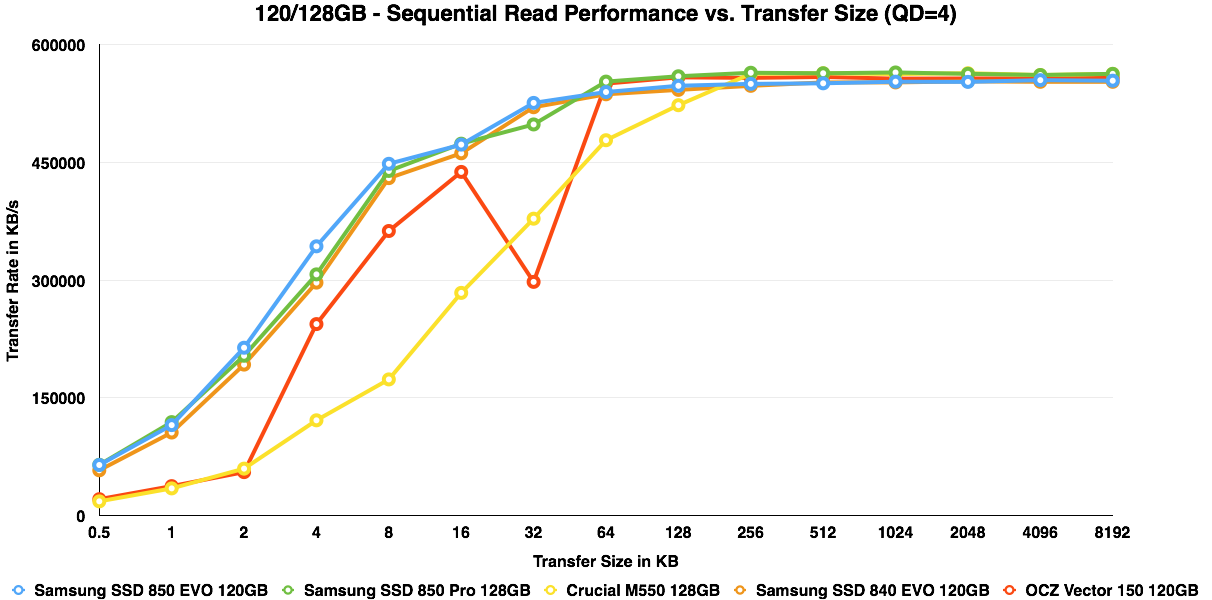Samsung SSD 850 EVO (120GB, 250GB, 500GB & 1TB) Review
by Kristian Vättö on December 8, 2014 10:00 AM ESTPerformance vs. Transfer Size
ATTO is a useful tool for quickly benchmarking performance across various transfer sizes. You can get the complete data set in Bench. The performance of the 850 EVO scales excellently across all transfer sizes, although I should note that TurboWrite has its fingers in play as ATTO's test size maxes out at 2GB, which is small enough that it will get written to the SLC buffer.












97 Comments
View All Comments
TheWrongChristian - Monday, December 8, 2014 - link
Performance consistency wise, the MEX controller on the 1TB drive looks better than the MGX controller on the smaller drives. I guess this is the loss of a cpu core at work, but I figure there'll be no discernible difference to the user experience.All in all, looks like a nice drive, a reasonable upgrade to the existing 840 evo drives. Just hope the V-NAND cost brings the whole price down to compelling levels as the process matures.
Solid State Brain - Monday, December 8, 2014 - link
As for the Wear Leveling Count, it might actually be taking into account that a fixed portion of the installed NAND is used in SLC mode for the TurboWrite buffer. The 120GB model has 128GiB of NAND, of which 9 GiB are used for 3 GiB TurboWrite Buffer, so that makes 119 GiB of TLC capacity for both overprovisioning and user addressable space.By the way, this also implies that because of TurboWrite these Samsung EVO SSDs (including the previous 840 EVO) have less overprovisioning space than most other SSDs.
Solid State Brain - Monday, December 8, 2014 - link
Yikes! This was not meant to be in response to TheWrongChristian.hojnikb - Monday, December 8, 2014 - link
>What I do know is that Samsung started the mass production of TLC V-NAND later, which suggests that the two aren't completely uniform. Moreover, from what I know TLC NAND requires some changes to the peripheral circuitry in order to read three bits from one cell, so while the NAND memory arrays could be alike the die size is still likely at least slightly different.Is it possible, that samsung designed 2nd gen 3D with TLC in mind (eg requred peripheral circuitry) and simply set the controller in 850PRO to use 4 states instead of 8 (so MLC). I mean, it kinda makes sense to go this way, but not the other way around....
Solid State Brain - Monday, December 8, 2014 - link
@Kristian VättöDo you have any information from Samsung about whether the TurboWrite SLC buffer also helps decreasing the write amplification like on the SanDisk Ultra II with nCache 2.0?
Kristian Vättö - Tuesday, December 9, 2014 - link
Unfortunately I don't. It was among the questions I sent but unfortunately Samsung couldn't get any of my questions answered on time for the review.Solid State Brain - Wednesday, December 10, 2014 - link
Too bad that you couldn't get an answer in time. According to my observations from other people's drives, it really looks like the Turbowrite does help on that regard. Try checking out my thread on the Memory and Storage forum.This phenomenon (write amplification just over or below 1.0x) is likely not going to show up during reviews or heavy usage since generally the drives get secure erased often and/or get hammered with writes which end up filling the Turbowrite SLC buffer.
Daniel Egger - Monday, December 8, 2014 - link
It would be nice to have some older drives in the charts to get some perspective on whether a drive would make a good upgrade choice. For an upgrade the available space and the space/price ratio are probably the most important aspects but some features or a major speed increase might sweeten the deal even more. ;)sheh - Monday, December 8, 2014 - link
Not perfect of always complete, but usable:http://www.anandtech.com/bench/SSD/65
Kvaern - Monday, December 8, 2014 - link
It's my anecdotal experience that all these awesome benchmark figures means absolutely nothing for the average user.Case in point I upgraded from an old 60GB corsair drive to an EVO840 which on paper is like twice as fast as the Corsair but in reality my user experience is exactly the same.